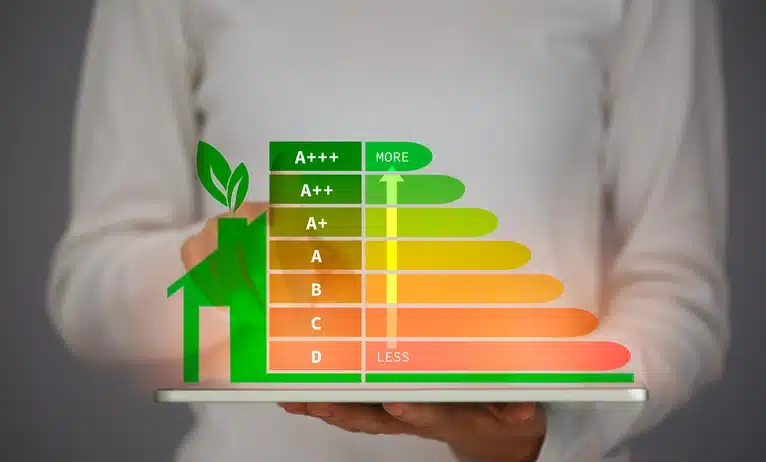Key Takeaways:
- HVAC efficiency affects utility costs and environmental impact, highlighting the value of high-efficiency models.
- Efficiency ratings like SEER, EER, HSPF, AFUE, and COP offer standardized metrics for comparing HVAC systems.
- High-efficiency HVAC investments reduce energy use, costs, and carbon emissions, benefiting both homeowners and the environment.
When it comes to maintaining comfort in your home, your heating, ventilation, and air conditioning (HVAC) system plays a crucial role. However, the efficiency of this system is not just a matter of comfort but also cost and environmental impact. With energy prices on the rise and a growing emphasis on sustainability, understanding HVAC efficiency ratings has become crucial for homeowners.
That said, this article will break down each efficiency rating, providing a detailed examination to help you evaluate and select an HVAC solution tailored to your home’s unique requirements while also fostering environmental sustainability.
What Is HVAC Efficiency?
HVAC efficiency refers to how effectively an HVAC system converts energy into heating or cooling for a space. This efficiency is a measure of the amount of energy used by the system to produce a certain level of comfort compared to the amount of energy consumed in the process. The higher the efficiency, the less energy the system uses to achieve the desired temperature, resulting in lower utility bills and a smaller environmental footprint.
Moreover, an efficient HVAC system not only conserves energy and saves money but also reduces wear and tear, extending the system’s lifespan and ensuring more consistent comfort levels within a space. Also, by reducing energy consumption, high-efficiency HVAC systems contribute to lower carbon dioxide emissions, playing a crucial role in environmental conservation efforts.
Decoding Efficiency Ratings
These ratings provide a standard measure of an HVAC system’s efficiency, helping you compare different models and technologies. Here’s a breakdown of the vital efficiency ratings you’ll encounter:
1. Seasonal Energy Efficiency Ratio (SEER)
The SEER is a critical metric for assessing the efficiency of air conditioners and heat pumps, focusing specifically on their cooling performance. It calculates the total cooling output provided by the equipment over the entire cooling season, expressed in British thermal unit (BTU). It divides this by the total electric energy input in watt-hours during the same period.
Furthermore, a higher SEER rating signifies a more efficient air conditioning system. The efficiency standards set by the U.S. Department of Energy dictate a minimum SEER rating of 14 for new systems in many regions. However, the most advanced models on the market today can exceed a SEER rating of 25.
2. Energy Efficiency Ratio (EER)
The EER serves as another vital measure of an air conditioner’s or heat pump’s cooling efficiency. Unlike SEER, which calculates efficiency over an entire season, EER provides a snapshot of a system’s efficiency at a specific outdoor temperature of 95°F (35°C), offering a clear picture of how effectively the system operates under peak conditions.
The EER is calculated by dividing an air conditioning system’s cooling output, measured in BTUs per hour, by its electrical power input in watts. Higher EER values indicate a more efficient air conditioning unit, highlighting the importance of this metric for those residing in warmer climates.
In such regions, air conditioners often run under conditions of intense heat, making the efficiency with which they operate a critical factor for both energy conservation and cost savings.
3. Heating Seasonal Performance Factor (HSPF)
For heat pumps, the HSPF is the equivalent efficiency metric for the heating mode of operation. HSPF calculates the total heating output in BTUs of a heat pump across the entire heating season and divides it by the total electricity consumed in watt-hours during that period. An elevated HSPF rating indicates a more efficient heating process.
In addition, the Department of Energy enforces a minimum HSPF rating of 7.7 for all new heat pumps, with the most efficient models today reaching ratings of 10 or higher. Investing in a heat pump with a high HSPF rating can lead to significant energy savings during the colder months.
4. Annual Fuel Utilization Efficiency (AFUE)
AFUE is a metric that evaluates the efficiency of furnaces and boilers by showing the proportion of fuel transformed into usable heat over a year relative to the total amount of fuel used. If a system has an AFUE rating of 90%, this signifies that 90% of the fuel’s energy is effectively converted into heat for the building, with the residual 10% lost, typically via the chimney or venting mechanisms.
The higher the AFUE rating, the more efficient the furnace or boiler is. Modern high-efficiency models can achieve AFUE ratings ranging from 90% to 98.5%. Selecting equipment with a high AFUE rating not only reduces fuel consumption and utility bills but also decreases greenhouse gas emissions, contributing to a healthier environment.
5. Coefficient of Performance (COP)
The COP is an efficiency ratio that applies to heat pumps, quantifying the amount of heat produced per unit of electrical energy consumed at a single point in time. It is calculated by comparing the ratio of heat output in BTUs to the electrical energy input in watts.
A higher COP value indicates a more efficient operation, with a COP of 2 signifying that the heat pump generates twice as much heat as the electricity it consumes. Since COP can vary with the operating conditions, it is essential to consider this rating in conjunction with other factors, such as outdoor temperature and heating needs, when evaluating the efficiency of a heat pump.
Conclusion
Through understanding these critical metrics, individuals can make educated choices in selecting HVAC systems that not only cater to specific environmental conditions and comfort preferences but also resonate with a commitment to reducing energy use and fostering a healthier planet.
